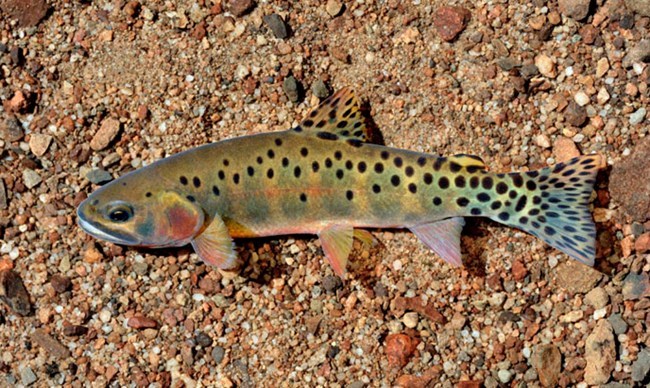
NPS Rio Grande Cutthroat TroutRio Grande cutthroat trout (Oncorhynchus clarki virginalis) historically occupied the upper portion of the Rio Grande Basin and associated drainages in Southern Colorado and Northern New Mexico. At present, Rio Grande Cutthroat only occupy about 15% of that range, mostly in the headwater streams in the upper Rio Grande watershed. 
NPS Photo Fishing in Great Sand Dunes National Park and PreserveGreat Sand Dunes National Park and Preserve offers fishing in accordance with State of Colorado regulations In the Medano and Sand Creek Drainages. For more information on how fishing regulations work in national parks, go to the NPS Fish and Fishing website. LicensesVisitors fishing within Great Sand Dunes National Park and Preserve must follow the fishing license requirements in accordance with the laws and regulations of the State of Colorado. Fishing RegulationsExcept as provided below, fishing shall be in accordance with the laws and regulations of the State of Colorado (36CFR2.3). For state fishing regulations go to the Colorado Parks and Wildlife website. The fishing regulations apply to all “finfish” found in the park. Other taxa, including amphibians, mollusks and crustaceans (e.g. waterdogs, crayfish) are not considered “fish” for the purpose of NPS fishing regulations and addressed by NPS regulations governing wildlife (36CFR2.2). These fishing regulations apply, regardless of land ownership, on all lands and waters within the park that are under the legislative jurisdiction of the United States. The following are prohibited:
Great Sand Dunes Fish Consumption AdvisoriesThere are no fish consumption advisories for Great Sand Dunes National Park and Preserve. Aquatic Invasive SpeciesImagine your favorite fishing spot and the wonderful memories. Things may look fine but underneath the surface there is a serious threat. Everything you remembered is now cemented together in a sharp, smelly mess. Invaders have wiped out the fish species you used to catch. Aquatic invasive species are not native to an ecosystem. Their introduction causes, or is likely to cause, harm to the economy, the environment, or to human health. Aquatic invasive species are a growing risk to parks and their values. In the United States alone, there are more than 250 non-native aquatic species. For many centuries, humans have contributed to spreading non-native species around the globe. You can make a difference. To learn more about Aquatic Invasive Species in the National Park Service, visit the Fish & Fishing website. How You Can Help – Stop Aquatic HitchhikersGreat Sand Dunes National Park and Preserve resource managers suggest that waders and other equipment used in other waters be cleaned and decontaminated prior to use at Great Sand Dunes to protect our waters from aquatic invasive species. Fishing Throughout the National Park Service
|
Last updated: May 1, 2025
